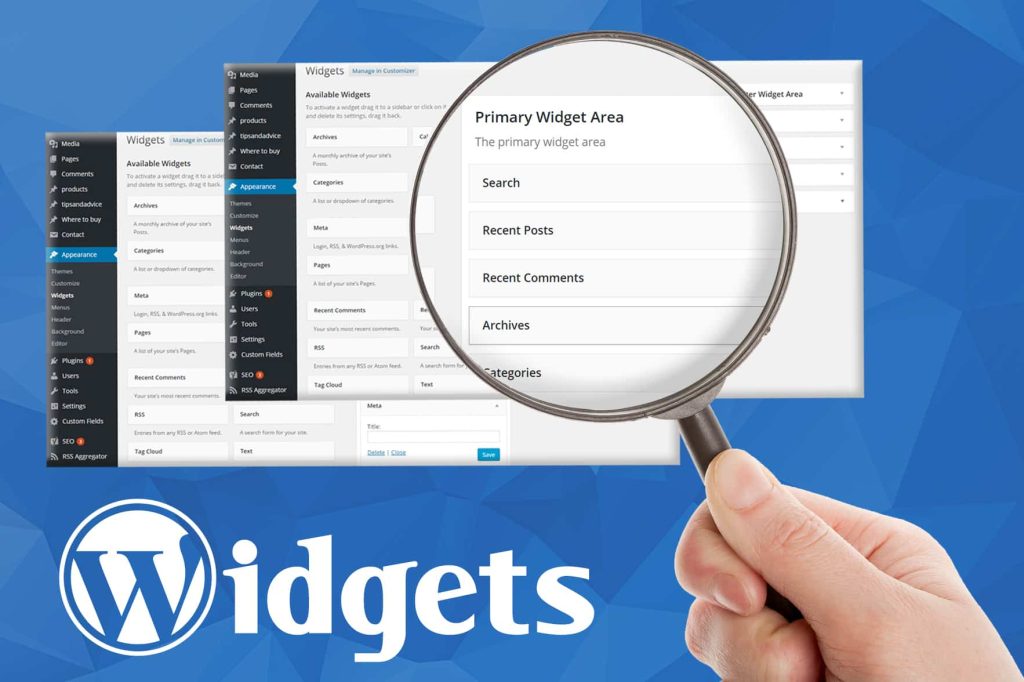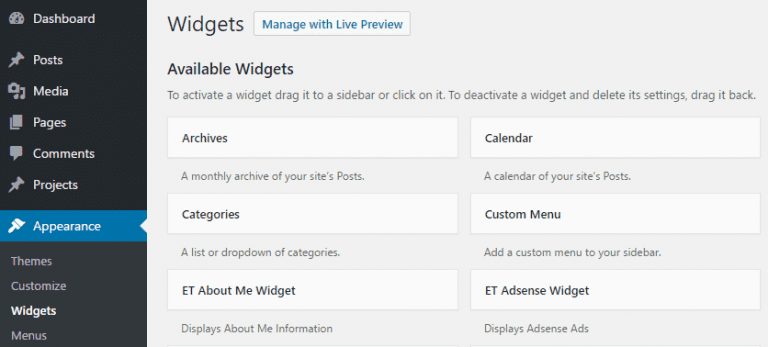Maximizing Your Site with WordPress Widgets
Widgets in WordPress play a pivotal element in forming the format and usefulness of a WordPress location. They provide a helpful way to encompass one-of-a-kind additives which include menus, sidebars, shapes, social media nourishes, and more, without the requirement for coding data. Employing leveraging widgets viably, region owners can make an active and lock-in client encounter that adjusts with their targets and targets.

Exploring various kinds of Widgets in WordPress
How do I create a widget in WordPress
Using WordPress Custom Widget
- Login to the WordPress dashboard
- Go to the Appearance menu, and select Widgets. You should see a widget named Hostinger Sample Widget in the Available Widgets list.
- Next, drag the widget and drop it in the Sidebar section on the right side of the page.
- Save your changes and visit your website.
Text Widgets
Textual content widgets permit customers to reveal custom content or HTML code in assigned areas on their website, which includes sidebars or footers. They may be flexible and can be applied for anything from displaying touch facts to placing third-celebration scripts.
Image Widgets
Photograph widgets empower customers to exhibit visuals along with emblems, pennants, or object pics in their area. They provide alternatives for personalization, counting photo estimates, arrangement, and connecting behavior.
Video Widgets
Video widgets deliver a clear manner to insert recordings from stages like YouTube or Vimeo straightforwardly into a WordPress area. That is especially treasured for sharing educational physical games, constrained time substance, or interactive media displays.
Custom HTML Widgets
Custom HTML widgets provide improved clients the adaptability to embed custom code scraps or scripts into specific tiers of their location. This could be convenient for coordination of 1/3-party administrations, inclusive of following codes, or executing custom functionalities.
How to encompass and customize Widgets in WordPress

Including and customizing widgets in WordPress is a clear manager that may be executed via the WordPress dashboard. Clients can get to the Widgets board, drag and drop widgets into craved gadget ranges, and layout their settings concurring to their possibilities.
Nice Hones for utilizing Widgets successfully
To make the maximum out of WordPress widgets, it is essential to follow some great practices:
Maintain widgets huge on your substance and audience.
Balance usefulness and aesthetics to maintain a cohesive design.
Often overhaul and keep up widgets to assure compatibility and protection.
Superior machine options and Plugins
For clients searching out more stepped-forward usefulness, WordPress gives picks like machine reason and device Perceivability plugins. Those apparatuses empower customers to manipulate wherein and whilst widgets display up on their place primarily based on particular conditions or standards.
Maximizing area Execution with Optimized Widgets
Optimizing widgets can contribute by using huge location execution employing lessening stack times and making strides in consumer involvement. This could be finished by using lightweight widgets, minimizing device over-burden, and executing gadget caching where relevant.
Widgets for Monetization advertising and marketing
For website online proprietors looking to monetize their area or strengthen objects and administrations, widgets provide vital apparatuses including advertisement association widgets, pamphlet signup shapes, and make contact with to-motion buttons. These widgets can provide help with pressure adjustments and profit generation.
Responsive Plan and Widgets
With the developing accentuation on flexible responsiveness, it’s fundamental to guarantee that widgets are congruous with exclusive devices and display screen sizes. Responsive plan standards must be connected whilst deciding on and customizing widgets to provide dependable involvement over all platforms.
Common gadget Botches to keep away from
Some not-unusual botches to preserve a strategic distance from while utilizing widgets encompass:
Overloading the region with superfluous widgets.
The use of widgets that aren’t optimized for overall performance.
Neglecting to check widgets over various devices and browsers.
Monitoring and reading gadget performance
To gauge the adequacy of widgets and optimize their execution, region proprietors can utilize analytics devices to music measurements including engagement, transformation charges, and jump fees. This information can offer assistance in apprehending tiers for enhancement and refining gadget procedures, therefore.
Future styles in WordPress device development
As WordPress proceeds to improve, we can expect to peer headways in system improvement, consisting of:
Extra cutting-edge customization options.
Integration with growing improvements such as AI and AR.
More suitable compatibility with third-party administrations and systems.
Bottom lines
WordPress widgets offer a capable manner to improve the usefulness, aesthetics, and purchaser encounter of your site. With the aid of know-how the numerous forms of widgets handy, leveraging exceptional hones for personalization and optimization, and keeping an eye fixed on future styles, you may maximize the capacity of your vicinity and stay ahead of the competition.
FAQs
- How do I add widgets to my WordPress site?
- To add widgets to your WordPress site, follow these steps:
- Log in to your WordPress dashboard.
- Navigate to the “Appearance” section and click on “Widgets.”
- You’ll see available widget areas on the right and available widgets on the left.
- Simply drag and drop the widget you want to use into the desired widget area.
- Customize the settings of the widget as needed.
- Click “Save” to apply the changes.
- Can I customize the appearance of widgets in WordPress?
- Yes, you can customize the appearance of widgets to align with your website’s design and branding. Most widgets come with settings that allow you to adjust parameters such as colors, fonts, sizes, alignment, and more. Additionally, you can apply custom CSS to further tweak the appearance of widgets if needed.
- Are there any performance considerations when using widgets in WordPress?
- Yes, there are several performance considerations to keep in mind when using widgets:
- Use lightweight widgets to minimize page load times.
- Avoid overloading your site with unnecessary widgets, as each widget adds to the overall page load.
- Optimize widget placement and caching to improve site speed.
- Regularly update and maintain widgets to ensure compatibility with the latest WordPress version and plugins.
- What are some popular widget plugins for WordPress?
- Some popular widget plugins for WordPress include:
- Widget Logic: Allows you to control widget visibility based on conditional logic.
- Widget Visibility: Similar to Widget Logic, this plugin enables you to show or hide widgets based on various conditions.
- Custom HTML Widget: Provides advanced customization options for inserting custom HTML code into widget areas.
- SiteOrigin Widgets Bundle: Offers a collection of useful widgets for various purposes, including image sliders, contact forms, and more.
- How can I track the performance of widgets on my site?
- You can track the performance of widgets on your site using analytics tools such as Google Analytics or WordPress-specific plugins like Jetpack. These tools allow you to monitor metrics such as widget engagement, conversion rates, bounce rates, and more. Analyzing this data can help you understand how effectively your widgets are contributing to your site’s goals and identify areas for improvement.

